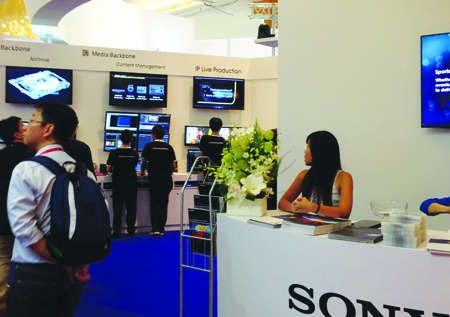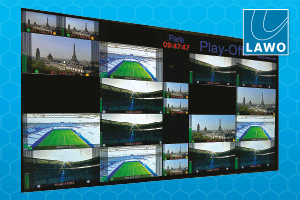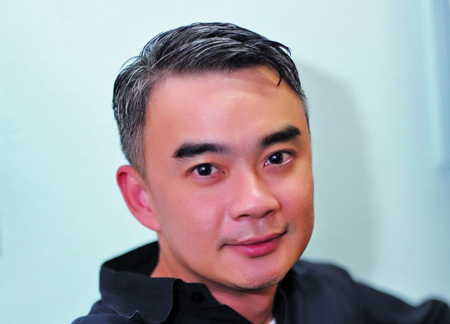BroadcastPro ME spoke to several industry players at BroadcastAsia last month. We bring you some sound bites from the exhibitors Micky Edwards, VP SALES EMEA & ASIA, Broadstream There is less hesitancy in the Asian market to go with the traditional approach. The European market, on the other hand, because of the economic slowdown, is hesitant about […]
BroadcastPro ME spoke to several industry players at BroadcastAsia last month. We bring you some sound bites from the exhibitors
Micky Edwards, VP SALES EMEA & ASIA, Broadstream
There is less hesitancy in the Asian market to go with the traditional approach. The European market, on the other hand, because of the economic slowdown, is hesitant about their purchasing decisions.
They are making do with what they have, and there is confusion over 4K and IP, what standards to adopt and how its going to affect them in the future.
Everyone seems to be asking if there will be resilience if they buy the systems now. A lot of projects are on hold at the moment in Europe, because there is more confusion on which direction to take.
There is more clarity in Asia in those terms, they are still building channels and there is potential to grow. Some of the Asian systems integrators are looking beyond their territories; we know of Korean SIs who are making inroads into Africa.
Oguz Erginer, Global Sales and Marketing Director, Erstream Video Delivery Co.
The broadcast industry is buzzing with discussions around OTT and 4K delivery. At BroadcastAsia, we showcased our 4K encoder to distribute 4K content at the rate of 5mbps with 10-bit colour. This results in major bandwidth and CDN savings for telcos and broadcasters.
We also presented end-to- end solutions for OTT platform delivery including a DRM (digital rights management solution).
This market (APAC) is full of surprises but as far as I can see, there is interest in deploying OTT solutions.
With regards to the Gulf region, there is a demand for our products including our CDN and encoding solutions.
We have also observed a growing interest in 4K encoding and OTT in the MENA region. We do not have an office in the Middle East just yet but we are planning to have a base there soon, in order to expand into that territory.
Ryan Welmans, Director Global Partnerships, PayWizard
BroadcastAsia is a significant show for us and we are here as exhibitors for the first time. We did see a handful of opportunities and had a lot of queries about our products.
As of now, we are trying to establish a foothold in the Asian market, which is relatively new for us. We need to adapt to the region in the way we deploy regionalised pricing to support the market in a competitive way. We need to be flexible in business.
While there is huge opportunity to do business in new territories, we foresee some challenges as well. We need to break into a new market, where we do not have a base yet or have any references from the region. We have worked with big players in Europe, such as BT Sports, NBCUniversal and others, but they dont have a presence in APAC or the Middle East. That will be a challenge.
Ben Pearce, Vice President, GBLabs
We are a storage and archiving manufacturer for the media industry and offer 4K- and 8K-capable storage. Although 8K is a relatively narrow market, there is a definite demand for 4K storage.
With Space SSD and the advent of 10Gb and 40Gb Ethernet, GB Labs was among the first to deliver fast shared storage supporting concurrent streams.
We can now support 8K workflows or HD environments with scores of concurrent users. Japan and Korea are our strongest markets, and we are also making inroads into Indonesia and Malaysia.
Carlton Smith, CPO, TMD
We have been coming here for many years, and several of the projects we have won throughout the region were born out of initial discussions at BroadcastAsia.
This year, TMD introduced a new range of packaged, off-the-shelf point solutions for archive, post-production and non-linear delivery. These are suited to small- and medium-sized companies or departments within large companies to address their specific application needs at entry-level prices.
The biggest trend we see in the broadcast industry today is meeting consumer demand for more content on more devices, delivered on more platforms. We have designed our solutions to help them generate new revenue streams and optimise assets while reducing costs. The need has never been greater for the savings that automated file-based workflows provide, on a system that is so intuitive to use that it can be made accessible throughout an organisation, and that requires very little training.
Will Munkara-Kerr, Area Sales Manager, EVS
This is the first time we are showcasing the newly acquired DYVI switchers. DYVI is a company that EVS wholly acquired recently.
The switcher offers a completely distributed model, which is fully scalable by software-based processing engines, rather than traditional switcher panels, and gives the option to have the processing units remotely connected to the hardware. This offers unusual and cost-effective workflows, as you can repurpose the power or desks themselves without actually having to move the equipment to multiple locations.
EVS has been building an ecosystem around our core technology of video servers, to be able to offer our customers best-of-breed solutions.
At the moment, DYVI runs independently in terms of development, and sales and marketing. In the next six-twelve months, it will be fully integrated into the wider range of EVS and will hopefully reflect in the integration of products themselves.
Richard Heitmann, VP Marketing, Aspera
Our focus at this show is on our FASP technology. In systems that cant rely on a CDN, we can deliver high-quality streams of data with very little buffering or startup delays, using FASP.
We have been asked by our customers to develop solutions to stream content as well. The key difference in file transfer and streaming is you dont care in what order you send the data; you can send those bytes out of sequence and the FASP stream is able to very quickly deliver the entire file. You can then retransmit, where needed, out of order and save the file at the other end.
FASP transfers achieve speeds that are hundreds of times faster than FTP/HTTP and provide a guaranteed delivery time regardless of file size, transfer distance or network conditions, including transfers over satellite, wireless and inherently unreliable long-distance international links. FASP also provides complete visibility into bandwidth utilisation and extraordinary control over transfer rates and bandwidth sharing with other network traffic. Complete security is built-in, including secure endpoint authentication, on-the-fly data encryption and integrity verification.
CDNs are great for certain things, but you cant always justify the cost of the service unless you can divide that cost across a broader distribution model. Bulk data streaming technology works well for media entertainment customers that want lower cost and high quality, or set-top box manufacturers that want fast streaming. We can also work with CDNs as an end-to-end access channel. Its particularly interesting for live events.
Nick Fitzgerald, CEO, TV2U
TV2U was born out of a company called Digital Rapids. I was one of the founders and was responsible for our Asia operations.
With a global platform based on cloud technology, we have a content hub with NTT Japan in their data centre in Kuala Lumpur. Free from any network disaster, away from fault lines, its secure and gives us connectivity to 140 countries.
We provide a managed service to our clients, who have an opex business model rather than capex. We are also a content aggregator and have an acquisition channel.
TV2U is now developing a Spotify for TV content. We can create it as a live asset, and add it to your EPG.
Based on your viewing habits, we can give you content thats within your profile. This is also hooked into social media. The analytics is agnostic to device or operator. Headquartered in the UK, TV2U is also located in Australia, Hong Kong, Kuala Lumpur and Singapore.
Danny Hodgetts, Sales Executive, Inview
Inview was recently selected by the National Broadcasting Commission of Nigeria to provide the national digital TV system, comprising set-top box software and integrated broadcast services over the digital terrestrial and satellite networks.
We are also targeting other key countries in Africa and emerging markets that are approaching digital switchover to replicate a similar business model to that in Nigeria. We work closely with pay TV operators around the world who want to quickly deploy connected services, providing a high-end user experience with a compelling interface on a low-cost set-top box, HDMI dongle or second screen.
There is a growing demand from operators for Inview to support their legacy set-top boxes that are already deployed in the field, to provide an improved user experience, new revenue generating services and a unified branded look and feel, even on very low-end set-top boxes.
David Abel, European Sales Director, Tedial
We work with systems integrator Magna Systems in the APAC region. We are still a new company here, having only just started in the region.
The Asian market, like any other sector, has various tiers of customers. There are tier-one and tier-two media organisations, which we need to understand.
Irrespective of the infrastructure, people want to consume content and are using multiple devices to do that. Your mobile is your HD receiver. Media companies want to exploit that, to make money from it. The idea is to produce content with the lowest possible cost and invest in solutions that are part of the infrastructure and create content more efficiently.
Broadcast and IT solutions are merging. We use the expertise of our IT platform in the marketplace, allowing businesses to migrate their current infrastructure into one that allows them to move further into the future. At the show, we presented Tedial Evolution among other MAM solutions.


















































































